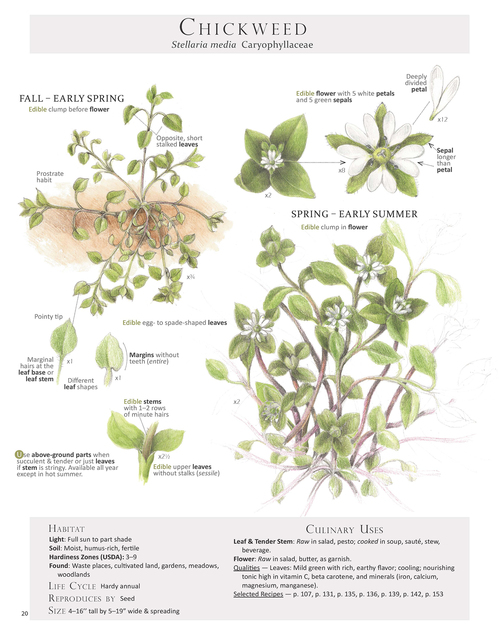The name chickweed originated from its use as a feed to birds especially young chickens. It has been used for centuries as a feed, but also as a tonic to cleanse the liver and kidneys. It was introduced in Eurasia and is now wide spread throughout North America including the alpine strain of chickweed. The alpine strain is called field chickweed and grows from Alaska to Colorado.
Chickweed grows well in shady and moist areas. It has a weak stem with tiny white flowers that bloom in late winter and leaves that grow all along the stem. It makes a great ground cover because of its tendency to grow outward instead of upward. Chickweed is a sign of fertile soil; the plant helps the soil to retain nitrogen.
 https://en.wikipedia.org/wiki/Stellaria_media#/media/File:Kaldari_Stellaria_media_01.jpg
https://en.wikipedia.org/wiki/Stellaria_media#/media/File:Kaldari_Stellaria_media_01.jpg
While doing my own experiments with the herb I found it to be very supportive in helping to relieve skin issues. Its ability to help to cleanse the liver helped to reduce my skin’s irritation and acne breakouts. I also had a test subject apply the herb topically in the form of infused oil. They applied the oil about 5 times a day directly to the psoriasis affected area and reported the use of the oil relieving the itching, drying and making it less scaly.

(from Foraging & Feasting by Dina Falconi)
MATERIAL MEDICA: CHICKWEED
Latin name: Stellaria Media
Family: Caryophyllaceae (Pink Family)
TCM Name: Yin chai hu
Parts used: Above ground plant
Preparation and dosage
- Tea: Use 1 tbsp in just boiled water to make an infusion.
- The leaves and stems can be chopped and added to a salad.
- An infused oil or salve can be made and applied topically.
- Add to a bath to calm dry or irritated skin.
Uses
According to The Desktop Guide to Herbal Medicine it is used to treat appendicitis, asthma, bladder irritation, bronchitis, constipation, cough, cysts, hoarseness, obesity, pleurisy, rheumatism, thyroid irregularities, tuberculosis and ulcers.
If used topically it soothes irritated skin and promotes healing. It helps to relieve psoriasis, eczema, itchy skin, varicose veins and inflammation of the eyes.
According to Planetary Herbology an infused oil of chickweed has similar properties to a cortisone cream (without the side effects!)
Chickweed is also highly nutritive, and makes an excellent addition to any daily tea blend you may enjoy.
Cautions
Excess use may cause diarrhea.
Sources
- The Herbarium's Chickweed Monograph
- Fundukian, Laurie J. The Gale Encyclopedia of Alternative Medicine. Detroit: Gale, Cengage Learning, 2009. Print
- Kershaw, Linda, A. MacKinnon, and Jim Pojar. Plants of the Rocky Mountains. Edmonton: Lone Pine Pub., 1998. Print.
- PDR for Herbal Medicine. Montvale, NJ: Thompson Healthcare, n.d. Print.
- Moore, Michael. Medicinal Plants of the Mountain West. Santa Fe: Museum of New Mexico, 2003. Print.
- Mars, Brigitte. The Desktop Guide to Herbal Medicine: The Ultimate Multidisciplinary Reference to the Amazing Realm of Healing Plants, in a Quick-study, One-stop Guide. Laguna Beach, CA: Basic Health Pub., 2007. Print.
- Tierra, Michael, and David Frawley. Planetary Herbology: An Integration of Western Herbs into the Traditional Chinese and Ayurvedic Systems. Twin Lakes, WI: Lotus, 1988. Print.
- Miner, Brigitte. Wild Herbs in Your Backyard. Placerville: New World, 1996. Print.



